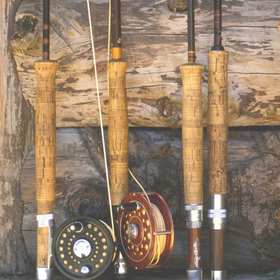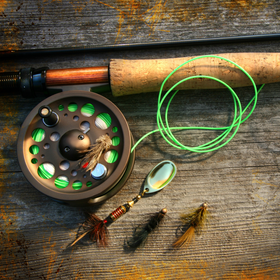Use at the start or at the end
Enticing a fish to strike, when they don’t appear to be feeding, is the goal of a group of fly patterns loosely called "Attractors.” They also are useful in finding where fish might be hanging out. Generally, Attractors are used when either all else has failed or when fishing in unfamiliar waters. I use them either first or last. Sometimes when used first they are fished all day, if proven successful. There are many qualities to a good attractor pattern. They are usually sub-surface patterns, although they don’t have to be. I like them to have color contrasts, sparkle, and life-like action.
For color contrast look for red or white. Trout and other gamefish often seem to strike less perfect imitations, when they contain red and white. For example the Prince Nymph is successful only when tied with the white wings. Although there are no real nymphs that have white. Many emerger patterns these days are tied with a white wingcase, to reflect the emerging wings when these nymphs swim to the surface to become adults. Other patterns that incorporate white are the Aggravator, Prince Pheasant Tail, and whole series of Prince nymph derivatives. Dry Flies also have incorporated white including the Royal Wulff, and the Parachute style of fly.
The color Red time after time triggers a strike response from trout. Also in the Royal Wulff, and Red-Tailed Prince. Fly fisherman have long used Red-Tail Mosquitoes in alpine lakes. Whether it appears to fish as an injured insect or they just attack when seeing red, it does prove to be a strike producer when nothing else will.
Sparkle or flash have long been incorporated into patterns. The Gold Rib Hare’s Ear is legendary partly because of its gold rib. The majority of nymphs are ribbed either with wire or mylar. Besides ribbing, flash can be added to tails, Wooly Buggers and Aggravator patterns with a few strands of Krystal Flash added, outperform those that don’t have it. As for life-like action, nothing beats marabou. Marabou comes alive underwater, undulating with in the waters current, or while stripping in lakes. Marabou is the tail in Buggers, and also can be added as gills in nymph patterns.
Another good material for attractor patterns is peacock. Wonderfully iridescent and reflective. Its subtle qualities mimic a plethora of insects both nymphs and adults. Used on Prince Nymphs, Zug Bugs, it is the thorax in Pheasant Tails, and can be used in Stimulators and Elk Hair Caddis as well. Attractors have their place in every angler’s arsenal, no matter what game fish they are pursuing. I know they have saved many a slow angling days for me, and other times they have provided some incredible fishing action for larger than average fish.
For color contrast look for red or white. Trout and other gamefish often seem to strike less perfect imitations, when they contain red and white. For example the Prince Nymph is successful only when tied with the white wings. Although there are no real nymphs that have white. Many emerger patterns these days are tied with a white wingcase, to reflect the emerging wings when these nymphs swim to the surface to become adults. Other patterns that incorporate white are the Aggravator, Prince Pheasant Tail, and whole series of Prince nymph derivatives. Dry Flies also have incorporated white including the Royal Wulff, and the Parachute style of fly.
The color Red time after time triggers a strike response from trout. Also in the Royal Wulff, and Red-Tailed Prince. Fly fisherman have long used Red-Tail Mosquitoes in alpine lakes. Whether it appears to fish as an injured insect or they just attack when seeing red, it does prove to be a strike producer when nothing else will.
Sparkle or flash have long been incorporated into patterns. The Gold Rib Hare’s Ear is legendary partly because of its gold rib. The majority of nymphs are ribbed either with wire or mylar. Besides ribbing, flash can be added to tails, Wooly Buggers and Aggravator patterns with a few strands of Krystal Flash added, outperform those that don’t have it. As for life-like action, nothing beats marabou. Marabou comes alive underwater, undulating with in the waters current, or while stripping in lakes. Marabou is the tail in Buggers, and also can be added as gills in nymph patterns.
Another good material for attractor patterns is peacock. Wonderfully iridescent and reflective. Its subtle qualities mimic a plethora of insects both nymphs and adults. Used on Prince Nymphs, Zug Bugs, it is the thorax in Pheasant Tails, and can be used in Stimulators and Elk Hair Caddis as well. Attractors have their place in every angler’s arsenal, no matter what game fish they are pursuing. I know they have saved many a slow angling days for me, and other times they have provided some incredible fishing action for larger than average fish.




